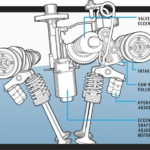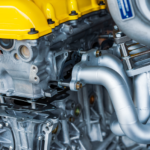The electronically controlled, cam-free internal combustion engine seemed like a good idea, but technical and market realities stifled its acceptance.
The camless engine is more than just a dream. In addition to working prototypes Sturman, Camcom, and Freevalve, manufacturers such as International Truck and Engine Corp (part of Navistar) had planned to use it in production trucks in 2007 models. Around the same time, a prototype camless truck successfully participated in the recent Pike’s Peak International Hill Climb, which covered 12 miles of winding roads to the 14,000-ft summit without breakdown. Renault of France was using a camless system with a solenoid actuator for some diesel cars by 2002.
Of all vehicle types, big trucks would likely have the most to gain in operating efficiency from the flexibility of camless engines. They would probably be the first vehicles with larger-scale deployment for the valves. In addition, such trucks usually have dedicated service facilities and more rigorous maintenance schedules.
But the reality is that electronically controlled camless ICE vehicles aren’t happening, not even in low volume, and they are unlikely to do so for several reasons (full disclosure: some of these points are the author’s opinions, others are backed by hard numbers):
- The performance and efficiency gain is modest, about 3 percent. While auto companies are going to great lengths for even that small amount of improvement, in this case, the “pain” and risk is still too high versus the potential gain. (For an example of the lengths to which auto companies will go for even a very modest gain of miles/gallon improvement, see the referenced EE World article on “Stop/Start”.)
- There is still a need to do a considerable amount of life testing and verification of the control algorithms, which enhance performance. Because camless control is so flexible, it gives car and truck manufacturers many more degrees of freedom and thus countless operating modes they need to test. In some ways, this flexibility can be too much of a good thing.
- It’s one thing to road-test tens or even hundreds of vehicles for 100,000+ miles to see how things work and fail. But in the auto business, the fact is that there will eventually be hundreds of thousands of vehicles on the road. In that situation, the law of large numbers nearly guarantees that there will be “tail cases” of problems occurring even in cars with fairly low mileage. These are the “oddball” cases where tolerances and other minuscule factors add up “just right” (or better, “just wrong”) to cause hard-to-diagnose yet genuine problems. The result is often a costly and embarrassing product recall – assuming a technical fix at the dealer is even possible.
- When serious investigation into camless systems was beginning, fuel injection was also coming into widespread maturity and used to replace the carburetor; it quickly became standard on nearly all vehicles. Using sophisticated algorithms to control and manipulate the fuel-injection cycle, many of the potential benefits of camless systems could be achieved but with no additional hardware cost or added reliability risk. In many ways, smart fuel injection greatly reduced the need for the potential benefits of the camless approach.
- Designing reliable and cost-effective under-the-hood components such as valve solenoids is a major development and validation undertaking, in addition to the eventual bill-of-materials costs. Despite its shortcomings, the pushrod and cam system is fully refined and proven. Its problems have all been worked out with respect to design, manufacturing, and reliability under a wide range of conditions, billions of miles, and many years. In other words, it is one less thing to worry about from procurement, production, reliability, and repair perspectives.
- Finally, auto manufacturers have chosen (or been pushed) to put most of their power-train research and development effort and budget into EVs and hybrid EVs of various types over the last decade or two. A recent article in The Wall Street Journal (see references) made this with some revealing and indisputable numbers.
Conclusion
Will we see camless, electronically controlled valves in ICE vehicles? It’s doubtful. The impetus for them has been overtaken by other ICE developments as well as the shift in auto R&D to non-ICE efforts. While there may be some specialty vehicles and custom engines that use the design, the mass market is no longer calling for this type of solution. Sometimes a good idea is just a little too ambitious, has technical and market problems, misses a market window, or poses a mass-market and long-term risk that is just too high to justify the cost and eventual returns it may bring. Proponents of the cam-free approach may like to say that adoption is “just around the corner” but the momentum seems to be long gone, to the extent it was ever there.
Related EE World Content
Understanding stop/start automobile-engine design, Part 6: Responses and work-arounds (has links to previous Parts 1 through 5)
Digital Valves Open Up New Possibilities For Engines
Single element, tooth-detecting speed sensor IC
References
- Car and Driver, “Variable Valve Timing Explained: An Appreciation of How Quickly Engines Operate”
- New Atlas, “World’s first fully digital valves open up engine possibilities”
- Motor Authority, “Fully digital valves could change the future of the combustion engine”
- Motor Authority, “ ‘Engineering Explained’ tackles Koenigseggs camless engine”
- Clemson University, “Electronic Valve Timing Control”
- Clemson University, “Camless Engines”
- Motor1, “Fully Digital Valves Could Massively Improve The ICE”
- Wikipedia, “Camless Piston Engine”
- Top Gear, “Here’s how the Koenigsegg Gemera’s 600bhp camless engine works”
- Hackaday, “Where Are All The Camless Engines?”
- The Wall Street Journal, “Gas Engines, and the People Behind Them, Are Cast Aside for Electric Vehicles”
- Wikipedia, “Desmodromic valve”
- Virtual Energy, “Camless Hydraulic Valve Actuation (HVA)”
- Machine Design, “Improving Car Engines with Advanced Variable Hydraulic Valves”
- Skill-Lync, “Design and MBD Simulation of IC Engine Valve Train and FEA Analysis of Rocker Arm”
- University of Waterloo, “New Fully Flexible Variable Valve Actuation System”
- University of Waterloo, “New Fully Flexible Variable Valve Actuation System”
- University of Waterloo, “Hydraulic Variable Valve Actuation System: Development & Validation”





Leave a Reply
You must be logged in to post a comment.